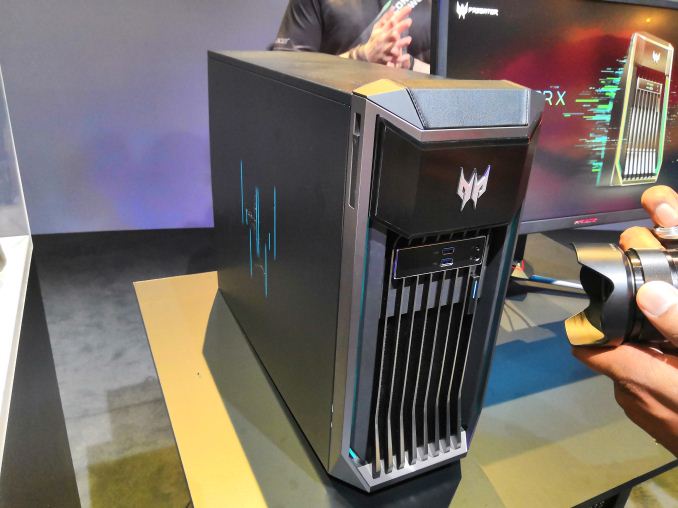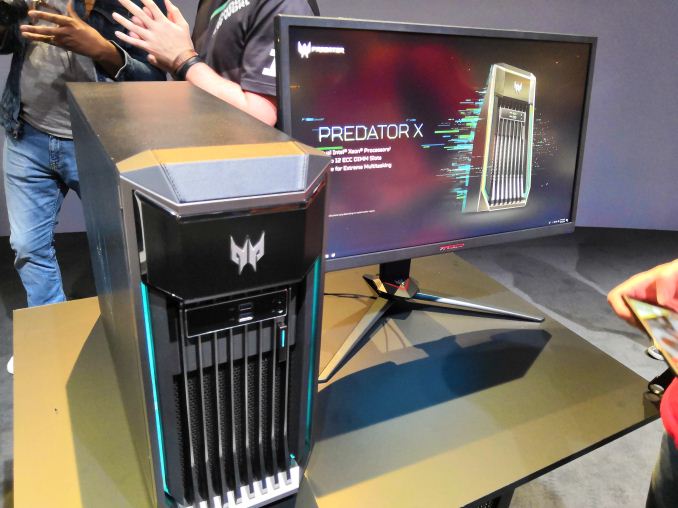Acer Wants To Sell a Dual Xeon Predator X System: Please No
by Ian Cutress on August 29, 2018 6:10 AM EST- Posted in
- desktops
- Gaming
- Acer
- Xeon
- Workstation
- Trade Shows
- NVIDIA
- Predator
- IFA 2018
- Predator X

Acer’s leading gaming branding, Predator, is all about maximizing performance, particularly around gaming. In the modern era, that now extends into content creation, streaming, video editing, and all the sorts of things that drive the need for high performance. As we’ve seen several times over the years, just throwing more cores at the problem isn’t the solution: bottlenecks appear elsewhere in the system. Despite this, Acer is preparing a mind-boggling solution.
The Acer Predator X is the new dual-Xeon workstation, with ECC memory and multiple graphics cards, announced today at IFA 2018. The premise of the system is for the multi-taskers that do everything: gaming, content creation, streaming, the lot. With this being one of Acer’s flagship products, we expect it to be geared to the hilt: maximum cores, maximum capacity. There-in lies the first rub: if Acer is going all out, this is going to cost something crazy:
- 2 x Intel Xeon 8180 ($10009 x 2)
- 12 x 16 GB ECC RDIMM ($200 x 12)
- 2 x NVIDIA Quadro RTX 8000 ($000s x 2)
- Some Storage
- Some big power supply
- Some custom chassis
Of course, Acer is focusing this product for the next generation of processors (read, Cascade Lake-SP), and so none of the specifications have been put into place yet. However, there’s a fundamental aspect to dual-CPU systems that needs to be addressed.
Dual CPU systems have what is known as a Non-Uniform Memory Architecture (NUMA) – despite each CPU having direct access to memory, without a NUMA-aware operating system or software in place, memory for one process on one CPU can be allocated on the memory of the other CPU, causing additional latency. We tested this way back in 2013, and the situation has not improved since. Most software assumes all the cores and memory are identical, so adding additional latency causes performance to tank. Tank hard.
Back in those 2013 articles, even scientific software was not built for multi-CPU hardware, and often performed worse than a single CPU with fewer cores. More recently, we’ve seen even single socket systems with a NUMA like environment such as the 32-core Threadripper 2 show performance deficits against monolithic solutions. Only in very specific scenarios (lightweight ray-tracing being the best), does performance improve.
When I approached the person who Acer put on stage to promote this new hardware for the Predator brand about these issues, he didn’t really have a clue what I was talking about. At first he confused it with having ECC, and describing the difference between bandwidth and latency seemed to go no-where. If Acer wants to promote this as a Windows machine, which I’m 99.9% sure they will, they really need to have some software wrapper in place to enumerate cores and put Core Affinity in place. Otherwise people will shell out a lot of money for, in a lot of cases, worse performance.
But hey, maybe Acer is going after the VM gaming market? Right?
One thing I was told is that Acer will be offering configurable variants. So you might be able to use a pair of Xeon Silver instead. Or remove that piece of 'leather' from the front of the chassis.


















37 Comments
View All Comments
PeachNCream - Wednesday, August 29, 2018 - link
The point is probably to have name and brand recognition from building and selling a few silly, but interesting on paper halo product systems to people who don't understand what they're purchasing. There's the secondary goal of selling said halo product with an absurd markup so the profit margin looks juicy-delicious to the corporate bobbleheads that approved it.alpha754293 - Wednesday, August 29, 2018 - link
Again, it depends.If they're smart about it, they can actually try to compete against Supermicro workstations in this space.
It's too bad that AMD Epyc hasn't caught up to the 2nd gen TR processors yet, because then it could be interesting to have a quad dual-socket 32-core AMD Epyc (256-cores/512-threads total) in a 2U rackmount because I can use up all of those cores doing what I do.
(My main central server has 80 TB raw storage, 70 TB RAID5.)
Diji1 - Wednesday, August 29, 2018 - link
>silly, but interesting on paper halo product systems to people who don't understand what they're purchasing.That just seems silly.
No one is spending this amount of money and not knowing what they're purchasing.
And somehow you already know their requirements before they do which is also silly.
alpha754293 - Wednesday, August 29, 2018 - link
The point is that consumer-grade hardware shouldn't even compete in the space that is dominated by enterprise-grade hardware.My decade-and-a-half old AMD Opterons are still running. My Core i7-3930K died and had to be replaced.
I'm slowly in the process of changing out all of my consumer-grade hardware based workstations over from Core i7s to Xeons.
Costs more, but they also are SIGNIFICANTLY less likely to die and can handle MUCH, MUCH, MUCH larger datasets.
This is the point.
diehardmacfan - Wednesday, August 29, 2018 - link
"Consumer-grade" and "Enterprise-grade" is somewhat a misnomer.An i7 is not significantly more likely to die than it's Xeon counterpart. The motherboard VRM's might, but this is a case-specific scenario that is determined by the "workstation" manufacturer (For example Dell Precision's use the same VRM's whether you get a Xeon or i7/i9).
No idea what you are talking about them being able to handle larger datasets, unless you are talking about Skylake-SP, which is basically Server only.
IUU - Saturday, June 8, 2019 - link
This is 2019. I think , that though so called enterprise-grade hardware may be in general better than consumer-grade hardware., there's much hype in so called "professional" applications and machines. I am still rocking a core i7 920 and would still be using an ATI-Radeon 4870 if AMD didn't render it obsolete by messing with the supporting software. The hard disk works flawlessly from that day, and so do the ram sticks. My ancient equipment is definitely consumer-grade and with low-credentials assembled in a lowly local business. Still it is chugging along for almost a decade like nothing happened. Conclusion is, there's too much hype in professional hardware; which is understandable , every business wants to make the bigger possible profits with a given product; but not acceptable when concerning my point of view and my purchasing decisions.Inteli - Wednesday, August 29, 2018 - link
That case looks suspiciously similar to a $50 Corsair case I've got...I'm also *really* curious who buys these workstations with gamer aesthetics. I don't see much of a point of the aesthetic on gaming computers, but especially not workstations with professional ambitions.
DanNeely - Wednesday, August 29, 2018 - link
I suspect they only sell 1 or 2 hand built boxes to the same sort of idiots who'll buy a Bugatti Veyron to go grocery shopping (as opposed to those who buy it for driving on a race track and dreaming of working for nascar/f1/etc). The actual cost of design/testing is probably billed to marketing since these exist just to generate attention by the press.matfra - Wednesday, August 29, 2018 - link
Thanks for trashing Acer, I don't feel alone in this world anymore.Achaios - Wednesday, August 29, 2018 - link
There are ppl with a lot more money than knowledge of PC's. For instance, I paid $1k to by a Core 2 QX9650 (Extreme) back in 2008 instead of a Q9650 for $300 b/c I thought (mistakenly) that the QX9650 would perform better than a Q9650 in gaming. Bottomline, this is a ripoff and they may very well sell it to ppl who have so much money that they don't know what to do with or ppl who just don't understand PC's.